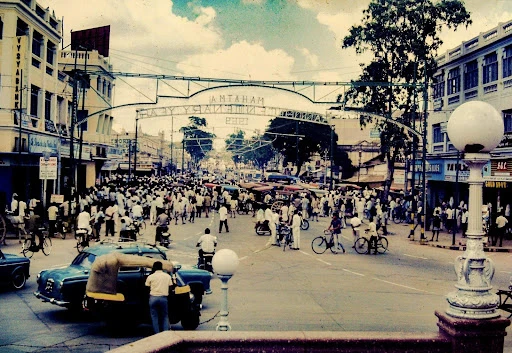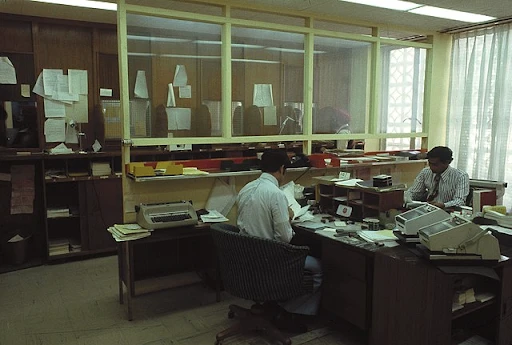From Taiwan to the Philippines to Bangladesh to Ghana , Frank Young’s career in the Foreign Service took him all over the globe. From his years as a student and researcher in India and Taiwan to his over three decades of service within the Foreign Service and the United States Agency for International Development (USAID) provided Young an intrinsic view of development as it relates to a nation’s unique form of governance, structure, and societal values. The transformation of the Taiwanese economy into the “Asian Tiger” designation following its international isolation in the 1970s is but one example of the developments Frank Young studied and witnessed as they occurred. Out of all his experiences within the development field, Young’s time living and working in India, starting in 1969, proved to be the most influential, both personally, as well as professionally. “That year in India was probably the most important decision I’ve ever made in my life.”
Before he arrived in India as a deputy program officer in the early 1980s, Frank Young first visited the country as a sophomore with Callison College during a year-long term abroad from 1969 to 1970. Experiencing a non-western culture for this prolonged period would prove to be the catalyst for his future career in the Foreign Service. The 1971 conflict between India and Pakistan occurred in the interim between Frank’s initial trip to India and his arrival in 1981 at the recently reopened USAID mission in New Delhi.

Relations between the United States and India had diminished after the United States aligned with Pakistan during the conflict. Pakistan’s loss in the war, and the liberation of East Pakistan with India’s intervention, damaged relations between Washington and New Delhi for almost a decade. When he returned to India in 1981, under the management of USAID Mission Director Priscilla Boughton, Young would have to recalibrate his expectations when working with his Indian counterparts. Indian input in development plans and program design involved vigorous and sometimes laborious negotiations, but the process allowed initiatives to be jointly developed in a manner that brought together both parties’ concerns. One example of this would be the Integrated Child Development Services Program (ICDS), which still sees use to this day, and involved a long, intense negotiation by both sides on its scope, funding, and oversight.
Frank Young would serve in several countries over his USAID career, including the Philippines (1977–1981), India (1981–1984), Bangladesh (1988–1994), and Ghana (1998–2002). Young would retire in 2016 following a career spanning thirty-three years within the Foreign Service and USAID. He would go on to publish a memoir in 2022 (47 Aerogrammes: A Passage Through India, 1969–1970) based on his first living experience in India. Currently serving as chairman of the Foreign Service Retirees Association of Florida and working as a mentor to USAID field officers shows that even after retirement he remains dedicated to the Agency and its mission.
Frank Young’s interview was conducted by John Pielemeier on May 4, 2022.
Read Frank Young’s full oral history HERE.
Drafted by Charli Portillo
ADST relies on the generous support of our members and readers like you. Please support our efforts to continue capturing, preserving, and sharing the experiences of America’s diplomats.
Excerpts:
“In India, my first great lesson was how to let government take the lead.”
Let the Lesson Take The Lead:

Q: In India or in the Philippines?
YOUNG: Yes, sorry. In India. In India, my first great lesson was how to let the government take the lead. India had a much stronger tradition of local governance, I think, than the Philippines did. We were reentering the India program in the early ’80s, after a rupture that had occurred because we took the wrong side in the India–Pakistan War in 1971, during which Bangladesh gained its independence.
Of course, we took the Pakistani side, the Indians were offended, and even though we had a very large program there, including PL 480, which was generating billions and billions and billions of Indian rupees in local currency, our whole aid program was suspended. And it was thanks to our partners like CARE [Cooperative for Assistance and Relief Everywhere] and CRS [Catholic Relief Services], who had extensive presence in India, and our FSN [Foreign Service National] staff in India that we were able to hold onto the basic structure of our presence so that we could restart when relations improved. During those interregnum years, they kind of kept ongoing programs, at least on the books. We were treading water, even though we didn’t have a formal, significant mission during those years. We started building up again in the early ’80s, so when I took up my posting there in ’84 we were in the midst of a major effort to design new activities. Designing new programs with the Indians was such a different dynamic compared to the Philippines. They actually brought to the table a lot of their own ideas.
“Bill, you don’t get it. When they say no, they actually mean, ‘Yes, we want you to come back with another idea.”
The Obstacle of Non-Objection:
YOUNG: Okay. So, you go back, come to them with another idea. And they’ll say no. And you do this maybe ten, twenty times, and it’s no, no, no, no, no, no, no, until you’ve whittled it down to something they’ll agree to. And then they say yes. The non-objection process is one of knocking down all the bad stuff until you get to the good solution. They actually call it the “non-objection process,” referring to a formal government protocol. It frustrated the ever-living hell out of the American staff, but having lived in India already, in the late ’60s, I’d already been exposed to this. I mean, it didn’t bother me that much. And, yeah, it took time. And Washington was impatient because they had deadlines for submitting project papers. You know, you had to have the PRP (project review paper) or PP (project paper) in by a certain deadline to meet the Bureau’s review schedule and then be able to develop a project agreement for signing to meet fiscal year deadlines. But you just couldn’t rush the Indians along. Your timeline was not their timeline.
I remember saying to our Ag Chief, Bill Janssen, when he was about ready to pull out what little hair he had left, because the Indians in his counterpart ministry just kept saying no to everything. I said, “Bill, you don’t get it. When they say no, they actually mean, ‘Yes, we want you to come back with another idea.’ No is kind of their yes, in a weird way.” He just looked at me like I was speaking Arabic. I mean, he just couldn’t make sense of it. I said, “No, think of it this way. If they say yes too soon, you have to be worried, because that means you haven’t thought of all the things that could go wrong yet. If they say no 20 times and then say yes, that means you’ve done the work.” That’s kind of what I’ve learned through this, that working through the Indian bureaucracy, as turgid and as awful as it sometimes was, often got you to the right answer because it’s the answer that they would go with. And that, in the end, pretty much had to be the right answer, until they themselves discovered that they had to change something.
“I was never completely confident that projects had the kind of local design and local input that they should have, but I was still comfortable going along with the Indian process.”
Local Government and Lingering Objections:
The second thing I learned in India by giving host country authorities the initiative to design and implement was that when they did make a mistake, and we could see it, more often than not they would admit it. And they worked with us to try and fix it. Ironically, the local level was a little more difficult, because while there was more significant authority in the local panchayats [village councils], the programs were all designed from Delhi.

I was never completely confident that projects had the kind of local design and local input that they should have, but I was still comfortable going along with the Indian process. And as I said, the ICDS program was a perfect example of how that worked. Programming local currency was a bit of a problem because we had to jointly program that with the Indians. I think conceptually, we always had a problem in believing that this really was their money, because its source was US provided grain that was sold locally for rupees. It was their currency. But because the currency generated was really part of a PL 480 loan we wanted to have a significant hand in deciding how it would be spent. We retained a substantial amount of currency for our own mission expenses, which was, you know, important given tight operating expense budgets. We owned so much of their currency that some worried it might destabilize the economy. We finally solved the problem by simply starting to write off the debt. It was after I had left, that we just wrote it all off, allowing the Indian treasury to take this substantial obligation off their books. When we did that, it removed a major irritant I think, between us and the Indian government.
Q: Treasuries are crucial, so you did that, right?

YOUNG: We did. We did, and I think the issue there was could you do it in such a way that it wouldn’t have a massive inflationary impact on the Indian government? Because that money was sort of sterilized. It was off book. We had to do it in a way that didn’t bring it on book and cause a big inflationary surge in their budget. So that was our argument with our Treasury in terms of writing it off.
We said, “Otherwise, what’s going to happen is, this stuff is still going to be around in 50 years, and it isn’t going to be worth much of anything. And oh, by the way, it is causing an irritant in the relationship that we don’t need, because we have other things that are more important to focus on.” And I think that was probably the right move.
TABLE OF CONTENTS HIGHLIGHTS
Education
BA in International Affairs, Callison College (1968–1972)
MALD/Ph.D. in International Development/Comparative Politics, The Fletcher School at Tufts University (1972–1976)
MS in National Security Studies, National War College (1996–1997)
Joined the Foreign Service 1976
New Delhi, India— Deputy Program Officer, 1981–1984
Dhaka, Bangladesh—Program Officer, 1988–1992;
Deputy Mission Director 1992–1993;
Acting Mission Director, 1993–1994
Washington, DC—Acting Assistant Administrator, Bureau for Asia, 2010 (Returned to USAID)
